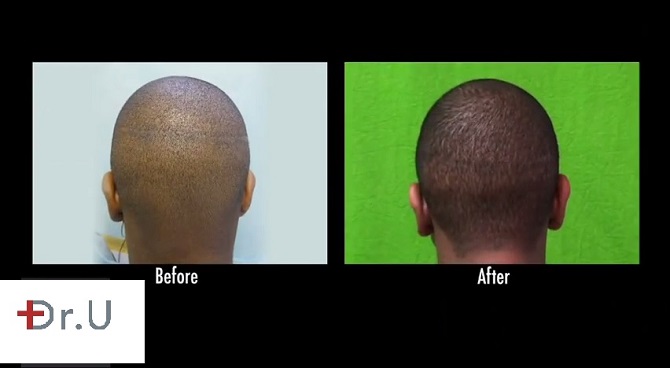The issue of graft injury and its ability to survive would certainly matter for hair growth yield.
Our photo and video galleries have many examples of patients who received little or no growth through strip surgery. Yet they were finally able to achieve what they wanted through UGraft Advanced Follicular Unit Extraction procedures here at our clinic.
This video by Dr U illustrates factors responsible for poor growth after a transplant:
Graft Survival in Follicular Unit Extraction Compared to Strip Surgery : Risk of Desiccation and Mechanical Injury in FUT and FUE Hair Restoration
- The concern over FUE (in terms of graft integrity) mainly has to do with the amount of tissue left around the extracted hair follicles. In strip surgery, an entire skin section from the lower portion of the scalp is removed with a scalpel. And individual follicular units are isolated as technicians use instruments to cut around each one. Some of the surrounding tissue will continue to adhere to the sides of the follicles. And this helps to keep the structures protected and hydrated as well. In Follicular Unit Extraction, a cylindrical punch is used to create circular excisions around each of the follicular unit. Since the diameters used are very tiny, there will be less tissue left on the outside of these structures, compared to strip surgery. And this is believed to put them at risk for desiccation (i.e. air drying which is the leading cause of death for follicular grafts). However, this would depend on the processes used by the surgeon and his/her team. Placing the graft immediately into an appropriate storage solution would prevent follicular death through air drying. Avoid FUE tools like neograft which use vacuum to suck out the grafts. The UGraft does not use vacuum instead has a graft hydrating mechanism that protects the grafts. Additionally the contour of the grafts results in extraction of bulkier grafts
- Also, transection (injury through surgical instruments) is also seen as a bigger concern with novice FUE hair transplantation. This can occur if the edge of the punch is misplaced and severs the follicle during the extraction phase. Or retrieving the follicles with forceps may forcibly injure the structures. But again, these occurrences (or lack thereof) would depend on the surgeon’s skill. This varies widely across practitioners of Follicular Unit Extraction.
Graft Survival in Follicular Unit Extraction Compared to Strip Surgery : A Focus on Results
Patients will likely find a focus on results to be more effective for their long term satisfaction, as opposed to nature of the technique. Growth yield and aesthetics can be best ascertained through before and after images of many types of patient cases. While before and after photos can be good indications of what a surgeon is capable of, videos are an even better source of information since they can feature the feedback of the patients (in their own words).

Another concern over graft injury is the possibility of wasting donor resources for future procedures. But this risk is also inherent with strip procedures. With FUE, extract counts of follicular units can be targeted with a digital counter marked by a foot pedal. However, in strip surgery, doctors can only estimate the number of grafts that the excised area can provide. The exact counts are determined after the follicles are dissected from the tissue section. If the strip excision was too big, there would excess follicles which would then be wasted.
Consult Dr U at no cost using this free online consultation form
Video on Strip surgery vs FUE which is better
